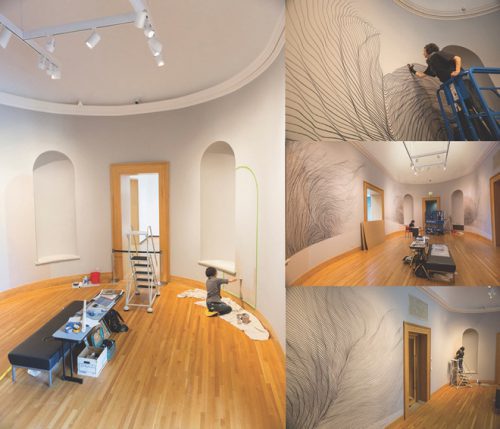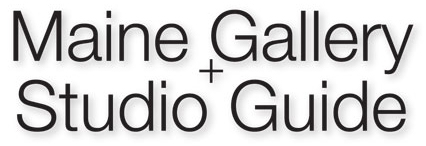
Bowdoin Museum Commissions Interactive Wall Drawing by Artist linn meyers Who Will be Artist-in-Residence at Bowdoin in Fall 2018
meyers Collaborates with Interaction and Sound Artists Rebecca Bray, James Bigbee Garver, and Josh Knowles to Create a Site Specific, Multi-Sensory Experience
The Bowdoin College Museum of Art (BCMA) announced today that it has commissioned a site-specific, multi-media art installation to be unveiled this fall. Washington, D.C.-based contemporary artist linn meyers will create a large-scale wall drawing entitled Let’s Get Lost, while serving as the 2018 halley k. harrisburg ’90 and Michael Rosenfeld Artist-in-Residence at the College. Concurrently, interaction and sound artists Rebecca Bray, James Bigbee Garver, and Josh Knowles, along with meyers, will create an interactive sound installation, Listening Glass, that corresponds with the wall drawing and features acoustic components activated through audience participation. The works will be exhibited together as Let’s Get Lost and Listening Glass at the Museum for a year from September 27, 2018 through September 29, 219.
For nearly 20 years, linn meyers has created large-scale wall drawings in both public institutions and private collections. Using paint markers favored by graffiti artists, she creates sprawling and oscillating linear patterns that activate spaces for visitors, reveal elements of a site’s architecture, and highlight the inevitable imperfections of the human gesture. For Let’s Get Lost, meyers will use the four niches in the BCMA’s Charles Follen McKim-designed Walker Gallery to drive the composition of her wall drawing. Her drawn piece will take cues from Listening Glass, using the sound project to inform the composition of the drawing, thus turning sound into drawn gesture. Listening Glass grew from meyers’s recent 2016–17 installation at the Hirshhorn Museum and Sculpture Garden, where she created a 400-foot long drawing entitled Our View From Here. While the work was on view at the Hirshhorn, Bray and Garver independently created an interactive sound installation as a response. The BCMA’s commission formalizes this partnership and makes it accessible for a broad public.
Using a custom iPhone app with advanced digital audio software and augmented reality technology, Listening Glass allows museum-goers to interact with Let’s Get Lost, to generate sound, creating improvised collaborative musical compositions using the drawing as a score. With the app on a handheld device, Listening Glass transforms the museum visitors’ gestures into sound, rendering the audience-performers’ motions in sonic triggers, audio distortion, reverberation, arpeggiations, and other expressive sonic events. The resulting sounds will emanate from each visitor’s iPhone, allowing sound and motion to connect audiences more fully to each other and to the drawn piece.

This project is a collaboration between the artists and the audience, pushing existing boundaries to create new compositional possibilities. In Let’s Get Lost and Listening Glass, drawing is explored as a multi-sensory experience, inviting responses through sight, sound, and movement. Listening Glass heightens the audience’s interaction with Let’s Get Lost from contemplative observation to active involvement.
“Let’s Get Lost and Listening Glass represent an innovative and powerful collaboration, demonstrating the exceptional potential of creative exchange across artistic boundaries,” said Bowdoin Museum Co-Director Anne Collins Goodyear. “We are excited about the many ways in which the artists have already engaged the Bowdoin community, bringing together students, faculty, and staff across the visual arts, music, and computer science departments,” continued Co-Director Frank Goodyear. “We hope to continue to foster opportunities for the Bowdoin community and the public at large to engage with contemporary art.”
In conjunction with the installation of Let’s Get Lost and Listening Glass, linn meyers will serve as the fourth annual halley k harrisburg ’90 and Michael Rosenfeld Artist-in-Residence at Bowdoin College for the Fall 2018 semester. The halley k harrisburg and Michael Rosenfeld Artist-in-Residence program allows Bowdoin Visual Art faculty to invite internationally renowned artists to campus to work directly with students from across campus in a range of disciplines, and the college community through critiques, discussions, workshops, lectures, and other activities.
Upon her appointment, artist linn meyers said, “I am honored to be the halley k harrisburg ’90 and Michael Rosenfeld Artist-in-Residence at Bowdoin College and am looking forward to exploring pressing interdisciplinary questions with faculty and students.” Explaining the project, she said, “Our team has been working to map gesture, drawing, and sound in ways that are intuitive and satisfying, encouraging surprising interactions and new kinds of spatial and sonic thinking.”
James Bigbee Garver continued, “For example, vertical movements of the handheld device can be mapped to resonance; rate of movement is mapped to loudness; color information is mapped to attack, decay, sustain, and release envelopes. When one or multiple participants are in the room, the ensemble of sounds from the handheld devices will voice the drawing’s score to varying degrees of complexity through improvisation.”
“Listening Glass,” Rebecca Bray continued, “allows the audience to collaborate with us to perform an audiovisual piece, using handheld devices to interact with a wall drawing to turn gestures into music. We anticipate some audience gestures will intuitively mimic the gestures which meyers used to make the wall drawing, and some will be very different. By listening to the sound emanating from their handheld device, participants will see the drawing anew–the interaction will connect them to the particulars of line, form, and space in the drawing.”
Speaking to the goals of the project, Josh Knowles added, “Listening Glass challenges us to consider how to make technology invisible while making interactions intuitive and rich with possibility. We seek to create a piece of technology that serves as a creative conduit between a person and a piece of visual art, an architectural space, and other viewers.”
meyers concluded, “The audience member will be confronted with questions about experiencing art, interpreting art, and the private versus social nature of perceiving and relating to art.”
About the Artists
linn meyers is an internationally-recognized, award-winning visual artist with work in public and private collections around the world. Celebrated for her large-scale wall drawings, her work relies on the constantly shifting nature of experience and what she calls the “unplanned imperfect.” Meyers has exhibited at the Hammer Museum, Los Angeles; the Phillips Collection, Washington, D.C.; the Smithsonian American Art Museum, Washington, D.C.; and the Hirshhorn Museum and Sculpture Garden, Washington, D.C.; among others. The recipient of a Pollock Krasner Award and a Smithsonian Artist Research Fellowship, she earned her B.F.A. from The Cooper Union and her M.F.A. from The California College of the Arts.
Rebecca Bray is an artist whose artwork spans performance, installation, and game design. She creates work that is deeply responsive to, and challenging of, audiences. Her work has been exhibited at the Museum of Modern Art, Hirshhorn Museum and Sculpture Garden, and the Whitney Museum of Art. Bray was previously the Chief of Experience Design at the Smithsonian Institution’s National Museum of Natural History and is the Managing Director of the Center for Artistic Activism.
James Bigbee Garver is a sound designer and composer, preferring the title of Sound Writer. He creates sonic inventions, soundscapes and music for live performance, interactive media, and film, often mixing the timbres of acoustic instruments with synthetic audio to sculpt imagined textures and environments. Garver has exhibited at the National Museum of Natural History, Washington, D.C.; the National Museum of American History, Washington, D.C.; and the American Museum of Natural History, New York; among other venues.
Josh Knowles is a software developer, game designer, educator, and electronic musician. His work explores the edges of technology and seeks to create seamless and beautiful relationships between people and information. Through his company, Frescher-Southern, Ltd., he has built creative technology projects for numerous brands and technology start-ups. Josh is an adjunct professor at NYU and a former member of the board of directors of the Austin Museum of Digital Art. He has spoken at conferences around the world about game design, digital audio, and software. Josh is also an award-winning digital musician.
Categories: Brunswick, exhibitions, museum, shows
Tags:

